The People’s Mojahedin; Iran’s Oldest, Largest, and Most Popular Resistance Organization
Peoples Mojahedin in Iran
The People’s Mojahedin of Iran (PMOI/MEK) is the oldest, largest, and most popular resistance organization in Iran. The PMOI was founded in September 1965 by three Iranian engineers who sought to replace the Shah’s repressive monarchy with a democratic government.
The PMOI enjoys broad popularity in Iran because of its longstanding support for democracy and its modern interpretation of Islam. The People’s Mojahedin believe Islam is inherently tolerant and democratic, and fully compatible with the values of modern-day civilization.
The People’s Mojahedin participated in a united front against the Pahlavi monarchy, which violently opposed democratic reforms and had one of the worst human rights records in the world. After the Shah fled Iran, the resistance organization worked to establish a democratic government, but Ayatollah Khomeini hijacked the Revolution and instead created an Islamic theocracy.
The PMOI shifted course and directed its opposition against the Ayatollah, continuing its struggle to restore democracy in Iran. In June 1980, the PMOI organized a rally in Tehran to protest Khomeini’s escalating despotism. More than 200,000 people participated in the demonstration.
Khomeini’s Hezbollah thugs tried to force their way into the stadium, clashing with PMOI supporters. Over bursts of machine-gun fire, explosions, and wailing ambulances, Rajavi yelled to the audience, “Do you hear?” addressing his words to the Khomeini regime and attacking Hezbollah. “We are neither Communists nor pro-Soviets as you claim. We are fighting for the total freedom and independence of Iran….Freedom is not granted,” he cried out as the audience jumped to its feet in support. “It is won. A gift of the Lord. It is as indispensable as oxygen.”
PMOI supporters leaving the event were attacked by the Hezbollah, leaving five dead and hundreds wounded.
With each passing day, the PMOI gained strength and in July 1980 Khomeini openly considered the possibility of defeat, stating, “Never have I so much feared the Islamic Revolution end in failure.” He lashed out at the PMOI, declaring the resistance organization as the main enemy. Khomeini said, “Our enemy is neither the United States, nor the Soviet Union, nor Kurdistan, but sitting right here in Tehran under our nose [the PMOI].”
Revolutionary Guards escalated their attacks on the PMOI, which continued to promote its pro-democracy campaign. The turning point came on June 20, 1981. The PMOI organized rallies across Iran to protest Khomeini’s oppressive rule. More than a half million Iranians attended the demonstration in Tehran.
On direct fatwa by Khomeini, the Hezbollah blocked off streets and fired weapons into the growing crowds, killing hundreds of Iranians and injuring many more, thousands arrested. The reign of terror had begun. The following day, Khomeini’s henchmen executed hundreds of PMOI supporters who had been arrested, including young girls.
The bloodbath was unrelenting. In the months and years that followed, more than 120,000 PMOI members and supporters were killed by Khomeini and the ruling mullahs. The savagery removed any legitimacy the Islamic Republic may have once had. The regime is now viewed by the people of Iran as fascist, maintaining power through fear and brutality.
Members and supporters of the PMOI have suffered greatly in their struggle to restore democracy to Iran. Iranians respect the many sacrifices made by the People’s Mojahedin and revere its martyrs.
Through the years, the People’s Mojahedin has been steadfast in its battle to rid Iran of the mullahs’ nightmare regime, overcoming severe hardships and setbacks. The support by the Iranian people for the PMOI is also steadfast. The resistance organization has earned their respect and trust and it gives voice to their aspirations for a free and democratic Iran.
Destroying the PMOI
The Iranian regime fully understands the threat the PMOI poses to it rule. Since Ayatollah Khomeini declared the resistance organization as the main opposition, nothing has changed. The People’s Mojahedin remains the main opposition and a growing force against the despotic rulers.
Tehran expends vast resources to counter the PMOI’s influence. At every opportunity, it seeks to destroy the resistance organization. The PMOI is daily pilloried with negative propaganda. Efforts to undermine the People’s Mohahedin reach to the highest levels of government. As an example, when US officials in 1985 sought the assistance of Tehran in freeing US hostages held in Lebanon, Iran’s mullahs demanded in return that the US government publicly demonize the PMOI as a Marxist and terrorist organization.
In 2003, French police raided the headquarters of the NCRI in Paris and arrested its leaders, claiming the group was “intent to prepare acts of terrorism.” An appeals court subsequently ruled there was no evidence to support the claims by the French government. It turned out that the raid was part of a quid pro quo deal with Tehran in exchange for lucrative business contracts for French companies operating in Iran.
Iran’s Ministry of Intelligence and Security (MOIS) uses coercion and bribery to persuade PMOI supporters to turn against the resistance organization. They operate as undercover agents, distributing false and malicious lies about the PMOI to government officials, NGOs, and the media. Many people have been duped by the mullahs’ ploy, echoing falsehoods about the People’s Mojahedin in reports and news articles.
One of the regime’s most often voiced myths about the PMOI is that it no longer enjoys the support of the Iranian public. The canard is often repeated by the mullahs and their proxies in the US and Europe. Seeking to diminish the resistance organization, they allege the PMOI is “viewed negatively by most Iranians” and that it has “virtually no support among the Iranian population.”
But nothing could be further from the truth. If the PMOI were so inconsequential, as the regime suggests, why does it spend tens of millions of dollars annually to attack the organization? Why does the regime daily vilify the PMOI in news articles and operate attack websites that spew black propaganda to undercut the organization? Why does it publish scores of anti-PMOI books and organize anti-PMOI exhibits throughout Iran if the resistance organization is a marginal entity?
If indeed the PMOI has “virtually no support among the Iranian population,” the regime is wasting massive amounts of time and money to defame the organization. Rather than ignore the resistance organization, the regime makes every effort to weaken the PMOI. And the reason they do so is because of public support for the People’s Mojahedin, which shares a yearning for freedom and democracy, the antithesis of the Islamic Republic.
PMOI Supporters in Iran
The exact number of PMOI supporters and sympathizers in Iran cannot be known because it is a crime to join or even express one’s support for the resistance organization.
Article 186 of the Islamic Punishment Act states that “members and supporters” of the People’s Mohahedin or anyone who “in any way is active or effective in advancing its cause” is “regarded as mohareb or guilty of “waging war on God.” Those found guilty of the crime are punishable by execution, hanging, amputation of the right hand and left foot, or banishment.
Given the extreme punishment for associating with the PMOI, people in Iran are obviously circumspect in revealing their ties to the organization. What can be stated is that many PMOI supporters in Iran have family members or friends who were persecuted and/or murdered by the Iranian regime. Others who are associated with the organization share the PMOI’s goal to bring the despotic rule of the Iranian regime to an end.
While the number of PMOI supporters in Iran cannot be tallied, it is possible to gauge the organizations’ support in Iran from their actions and by the regime’s exhaustive efforts to counter the resistance organization, belying the myth that it is insignificant and disfavored by the public.
“Death to the Monafeghin”
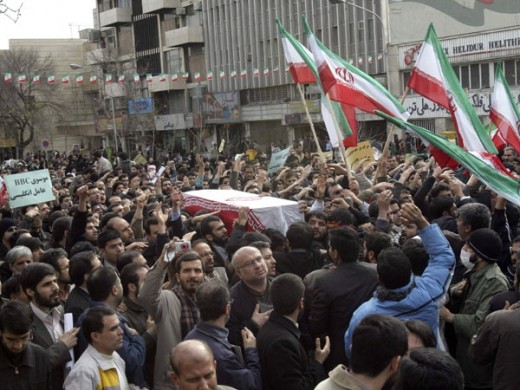 The Iranian regime labels the PMOI as “monafeghin,” a derogatory term meaning “hypocrite.” Ayatollah Khomeini first tagged the group with the negative moniker in a speech in June 1980.
The Iranian regime labels the PMOI as “monafeghin,” a derogatory term meaning “hypocrite.” Ayatollah Khomeini first tagged the group with the negative moniker in a speech in June 1980.
“Death to the monafeghin” is another common refrain chanted at government rallies and at the end of every Friday prayer, along with the phrase, “Death to America.”
The slogan is also intoned in the morning. “Children, as young as seven, are taught to start the day by fouling the “monafeghin” (MEK Iran), as well as the US and Israel in their morning chants,” according to a news report.
It makes no sense for the regime to malign the PMOI at government rallies and at Friday prayers, elevating the resistance organization’s public profile, unless the mullahs actually believed the group had substantial support and was a continuing threat.
Iran National Television
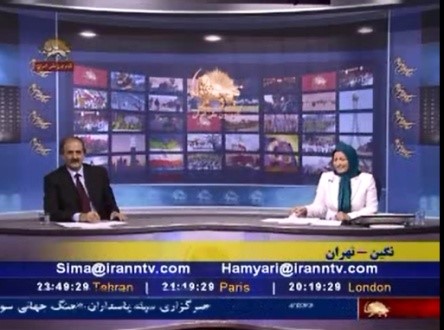 Although the PMOI must operate in the shadows in Iran, the organization maintains a high public profile due to its satellite television channel, Iran National Television (INTV). In Persian, it is called Simay-e Azadi or the Voice of Freedom.
Although the PMOI must operate in the shadows in Iran, the organization maintains a high public profile due to its satellite television channel, Iran National Television (INTV). In Persian, it is called Simay-e Azadi or the Voice of Freedom.
INTV, founded in 1996, communicates 24/7 to the Iranian public, as well as other parts of the world. The channel’s stated purpose is to “provide a truthful media outlet to foster a democratic Iran that respects the human rights of all.”
INTV fulfills an important role in Iran, where a free press is prohibited and the flow of information is highly restricted. The satellite channel, based out of London, operates commercial-free and is run largely with the assistance of volunteers.
INTV’s reporters have an extensive network of contacts inside Iran from which they gather information on events within the country. INTV broadcasts news reports on the inner workings of the government and anti-regime protests, both of which are heavily censured by the regime-controlled media.
Many expats also rely on INTV for news about Iran. INTV has an estimated 10 million viewers and its popular website receives tens of thousands of hits daily.
In addition to news, INTV broadcasts programs on Iranian history, literature, culture, art, music, and comedy, as well as documentaries that are unavailable to domestic audiences.
A 2013 report by the Islamic Republic of Iran Broadcasting (IRIB) said more than 42% of Iranians watched satellite TV programs and, on average, they spent three hours a day viewing foreign broadcasts. Some news channels, the head of IRIB said, “had penetrated a majority of Iranian households, such as Simay-e Azadi….”
Telethons
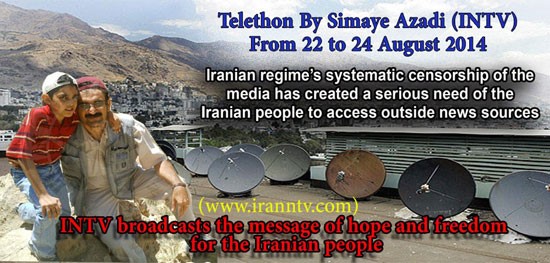 INTV periodically conducts telethons to generate funds to operate its satellite broadcast channel. The contributions from the telethons can be viewed as a measure of the PMOI’s popularity both in Iran and by the expat community.
INTV periodically conducts telethons to generate funds to operate its satellite broadcast channel. The contributions from the telethons can be viewed as a measure of the PMOI’s popularity both in Iran and by the expat community.
A 50-hour INTV telethon in late January 2013 generated $4.1 million. Twenty-two phone lines were set up to receive calls. Contributions were also pledged by email, twitter, and on chat lines. Dozens of members of parliaments in Europe participated in the event, encouraging viewers to make donations. Contributions ranged from one dollar to several thousand dollars and were received from donors throughout Iran and 31 other countries.
Many PMOI supporters took the opportunity to send messages. Firoozeh in Mashhad contributed $54, stated, “I salute the leadership of the Resistance. I am from unit of Saba Haftbaradaran and we are standing to the end.” Another contributor forwarded $50 along with the message, “Simaye Azadi is the voice of the Iranian people.” An anonymous contributor from Khozestan sent $1,500, saying “I present you the contribution of a group [of] university professors who support the PMOI.” Shahryar, from Karaj, Iran’s fourth largest city, gave $216, declaring, “I am supporting you from the unit of Bardia Mostifian. Down with velayat-e faqih!”
Satellite Dishes
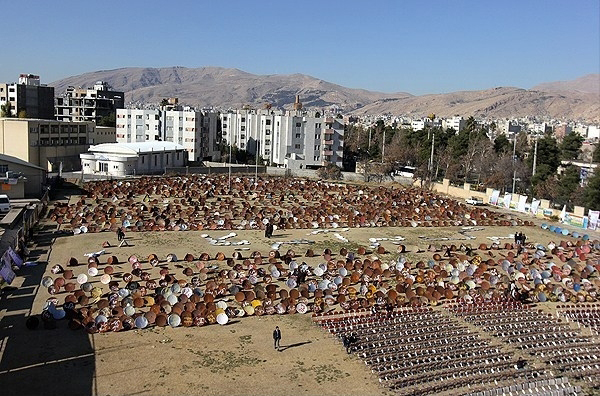 Not surprisingly, satellite dishes in Iran are banned. Even though owning a dish is illegal, it’s believed that 50-70% of the Iranian public watch satellite television broadcasts, according to Fardin Ali-Khah, a sociology professor in Tehran. “Although their use is forbidden,” he said, “they can be seen everywhere.”
Not surprisingly, satellite dishes in Iran are banned. Even though owning a dish is illegal, it’s believed that 50-70% of the Iranian public watch satellite television broadcasts, according to Fardin Ali-Khah, a sociology professor in Tehran. “Although their use is forbidden,” he said, “they can be seen everywhere.”
A report by a research center for Iran’s Majles (parliament) said a large number of Iranians use satellite dishes to gain “access to news and analysis.” It further stated that measures taken by the government to restrict the use of satellite communications had “not achieved the desired result but [had] brought a craving for satellite use in most and the poorest villages and city suburbs.”
 Iranian authorities regularly conduct raids to confiscate satellite equipment. On August 14, 2013, for example, police descended on 19 cities across Iran, collecting some 16,000 illegal satellite dishes. A satellite manufacturer was shut down and 107 people were arrested.
Iranian authorities regularly conduct raids to confiscate satellite equipment. On August 14, 2013, for example, police descended on 19 cities across Iran, collecting some 16,000 illegal satellite dishes. A satellite manufacturer was shut down and 107 people were arrested.
Officials also offer compensation to Iranians to persuade them to surrender their satellite dishes. “Citizens who hand over satellite receivers will receive a sum of money as appreciation and encouragement,” a commander of the Revolutionary Guard announced.
Satellite dishes were made illegal in 1994. Persons caught using the equipment can be fined up to 3 million Iranian Rials (about $105).
Abdul Reza Dashi, a commander of the Basij, an auxiliary security force in Iran, said the “battle against satellite TV and social networks on the Internet is more important than the effort of achieving chemical and atomic weapons.”
An increasing number of Iranians appear to be turning to satellite channels for news, including INTV, in response to the government’s crackdown on the Internet and the tracking and arrest of online activists.
Jamming Satellite Signals
The regime has periodically jammed satellite signals to prevent Iranians from watching INTV and other channels. INTV has had to move its signal to other satellites (PanAmSat, AsiaSat, ArabSat, Eutelsat, and Hotbird) on numerous occasions to avoid being jammed.
In recent years, the level of jamming has diminished. Other satellite channels jammed by the regime include BBC Persian Television, Voice of America PNN, Rangarang, and radio Zamaneh.
Gholamreza Khosravi
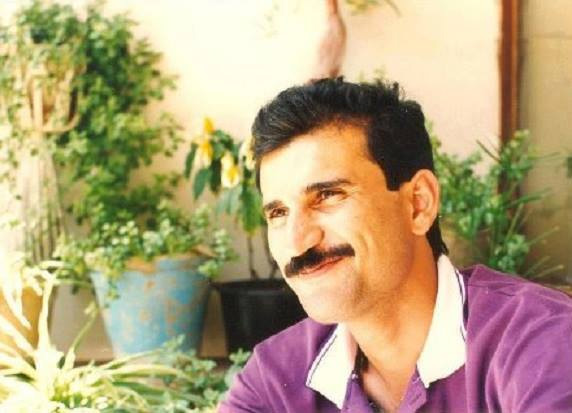 The execution of Gholamreza Khosravi Savadjani, 51, may be the first case in which a person was killed for sending information and making a contribution to a TV channel.
The execution of Gholamreza Khosravi Savadjani, 51, may be the first case in which a person was killed for sending information and making a contribution to a TV channel.
Savadjani was arrested in 2007 and initially sentenced to six years of hard labor, with three years suspended. Iran’s Ministry of Intelligence and Security appealed the sentence and a judge resentenced Savadjani to six years in prison.
In July 2011, Savadjani was transferred to a court in Tehran, which convicted him of moharebeh or “waging war on God.” On June 1, 2014, he was hanged to death.
Savadjani said, “The basis for my death sentence is that I have exposed the brutality of the Ministry of Intelligence and refused to provide information and doing TV interviews, renouncing the MEK.”
Savadjani confessed he had sent INTV information and had offered a financial contribution. “These activities of mine had been uncovered and the regime had me under surveillance,” he said. “I confirm I did this.”
TV Anti-PMOI Propaganda
The regime regularly produces TV programs, even including a soap opera, that defame the PMOI. After the 2009 uprising, Tehran boosted its propaganda campaign against the People’s Mojahedin, increasing the number of TV series and films that attacked the organization. Below are details from some of the productions by state run TV stations:
- “Gorgha” – authorities said the TV series about the PMOI would have a” considerable impact in eliminating the notorious terrorist group from the political scene in Iran.”
- “Zel’e Sevom” – a TV series focused “on the birth and demise of the MEK group,” produced at the Sima-Film center.
- “Gery-e Khamoush” – a documentary “about confessions of MEK members.”
- “Parvaneh” – a 15 part series on the PMOI, produced for the “Fajr Decade,” an annual event commemorating the ’79 Revolution and Ayatollah Khomeini’s return to Iran. The series was later broadcast on national TV.
- “An End to End” – the TV series “studies the terrorist MEK group from the beginning of its formation until now and the trend it has developed.” It “uncovers their ugly acts and exposes the reality and leaves viewers to make up their own judgments.” About the first episode, “Rajavi [head of the MEK] is far less worthy of being analyzed and studied, however, looking into the issue of hypocrisy, the organization is valuable since it will unveil the Satan’s demagoguery.”
- Black Dream – the 15-part TV series produced in 2013 described the resistance organization as the PMOI rather than monafeq or hypocrites. As explained by the government-run Mehr news agency, “It was once decided that the PMOI’s actions not be highlighted, fearing it could only advocate for the group.” The producer of the TV series said he thought the regime’s refusal to address the impact of the PMOI in Iran had been a “mistake.”
2009 Uprising
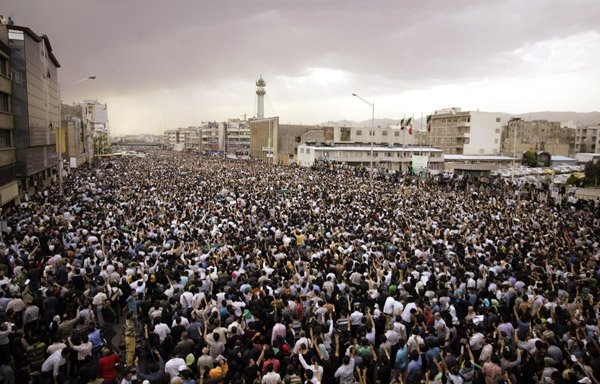 In June 2009, two hours after voting booths closed in which 40 million Iranians was announced to have cast a ballot, President Ahmadinejed was announced as the winner of the presidential election with 62% of the vote.
In June 2009, two hours after voting booths closed in which 40 million Iranians was announced to have cast a ballot, President Ahmadinejed was announced as the winner of the presidential election with 62% of the vote.
The three opposition candidates said the election had been rigged and the vote tally manipulated to favor Ahmadinejed. In subsequent investigations, the turnout at 30 polling sites reportedly exceeded 100% and at 200 other sites turnout was greater than 95%.
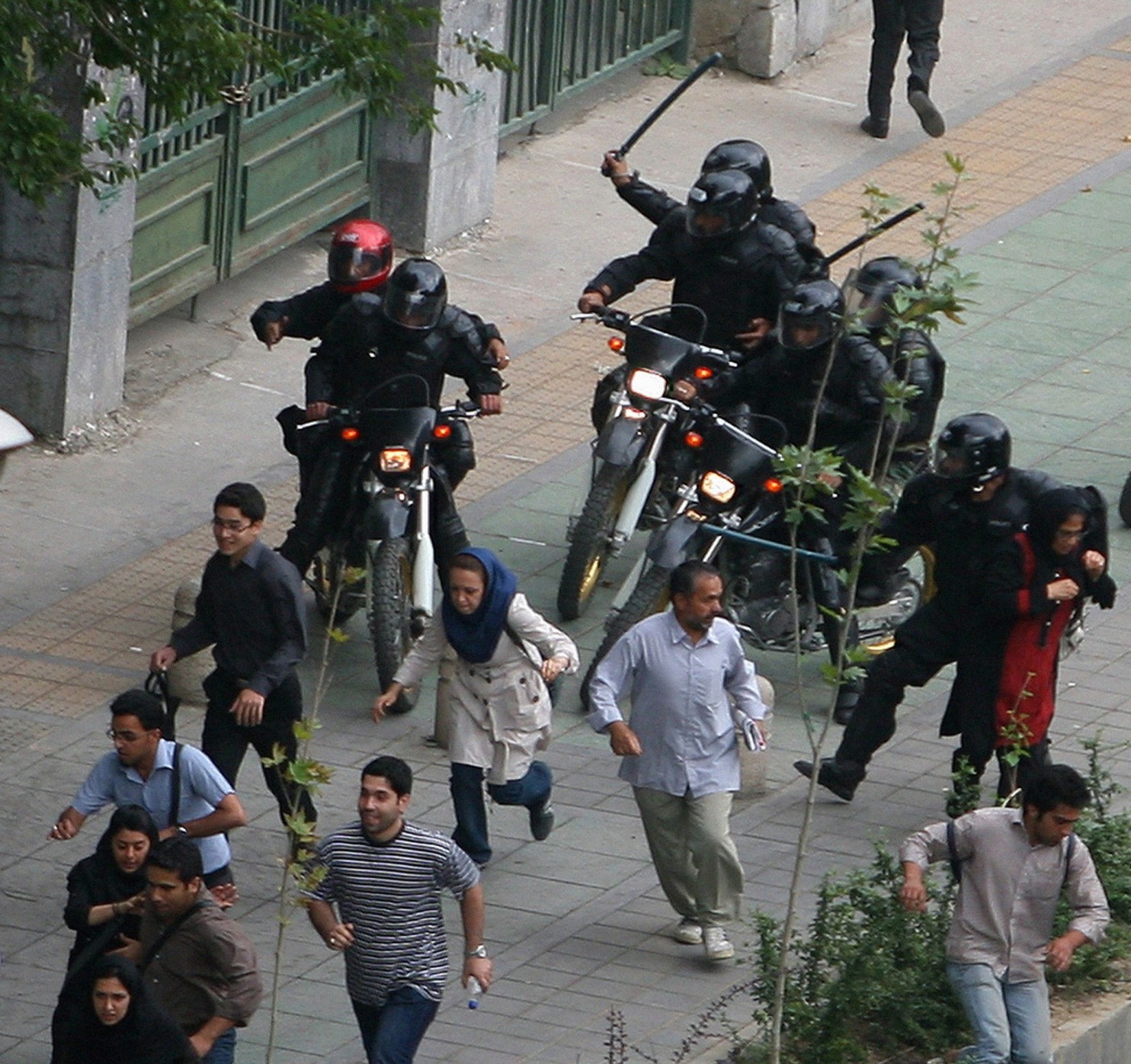 Iranians flowed into the streets to protest against the fraudulent election. The People’s Mojahedin, along with other groups, including the newly formed Green Movement, worked behind the scenes to organize the protests.
Iranians flowed into the streets to protest against the fraudulent election. The People’s Mojahedin, along with other groups, including the newly formed Green Movement, worked behind the scenes to organize the protests.
The Green Movement focused its demonstrations on the election results, chanting at rallies, “Where is my vote?” The PMOI’s slogans targeted the regime. Supporters chanted, “Down with the principle of velayat-e faqih” and “Down with the dictator.”
(Velayat-e faqih, meaning “guardianship of the jurist,” is the guiding principle of the Islamic Republic. Incorporated into Iran’s Constitution, it places a Supreme Leader (vali-e faqih) at the head of government. Fundamentalists believe the Supreme Leader is “God’s representative on Earth” and his legitimacy is “divine.” The PMOI believe only fair and open elections and public suffrage give political legitimacy and are opposed to velayat-e faqih.)
Within weeks after the first protests, the PMOI’s slogans dominated the demonstrations, reflecting the public’s support for the group and its agenda, as well its influence in directing events.
Authorities banned the anti-government rallies and blocked websites and cell phone transmissions to impair the protestors’ ability to organize. Dozens of people were killed and many were arrested, including members of the PMOI and the Green Movement.
Many of the Green Movement members had been associated with the regime and they subsequently were released for the most part. The harshest punishment was reserved for PMOI members and sympathizers. Saieed Mortazavi, the Prosecutor General of Tehran, discussed the role of the PMOI in the uprising in a report he presented to the Iranian parliament. Jomhuri Eslami, an official government newspaper, published an article on his presentation, stating:
- “In this joint session, Tehran’s prosecutor [Mortazavi] presented a report about street people and the Monafeghin [PMOI] acting in an organized manner who were arrested and also a report about those plotting for a velvet coup … Mortazavi said the Monafeghin played a role at three main points in the event in an organized way and calculated manner. He added that some of the Monafeghin had infiltrated the election headquarters of some of the candidates and some were responsible for directing and leading the riots. A representative said that some of the Monafeghin acted as the riot and the velvet coup instigators. He said the three groups are in jails now.”
Numerous other reports and articles in Iran give details of the PMOI’s involvement in the demonstrations.
- Iran’s Deputy Minister of Intelligence, commenting on the protests, said, “Based on the call from the Monafeghin [PMOI] organization, members of the group in all the scenes of the riots were present and led the disturbance.” He added that “the strategy of the Monafeghin in being present in the riots was opportunistic. Since they are an armed organization against Iran, all the people arrested are considered to be “moharebs.”
- In Ghazvin province, about 150 km northwest of Tehran, “seven people affiliated to the anti-revolution group were arrested following efforts made by unknown soldiers of the Imam-Zaman (MOIS agents)….They were sent to prison after coordination with judicial authorities. Those arrested have a background in connection with the anti-revolution group [PMOI]. They participated in the recent riots in Ghazvin and Tehran.”
- The PMOI acquired copies of sensitive documents produced by the MOIS about the uprising, including interrogations of resistance members who were arrested at protests. In the documents, the MOIS said “60% of the youth arrested were in contact with the Mojahedin or were influenced by them.”
- Neday-e Enghelab, a media outlet for the MOIS, released documents related the 2009 uprising, stating “the Monafeqin [PMOI] group had a comprehensive and well calculated plan to spread the riots.”
- In January 2011, Tehran authorities confirmed the execution of Jafar Kazemi and Mohammad Ali Hajaghaei, both members of the PMOI. The Tehran Prosecutor’s Office said “these two hypocrites were members of an active network of the said group [PMOI] and were involved in the (post-election) riots under the guidance of their ringleader in England.”
- Tehran Chief Prosecutor Abbas Jafari Dolatabadi said “the execution of six active members of the opposition [PMOI] who were arrested following the demonstrations after the presidential elections of last year, had been confirmed.” He added the members were “alleged to belong to the exiled illegal group, the Mojahedin Khalq.”
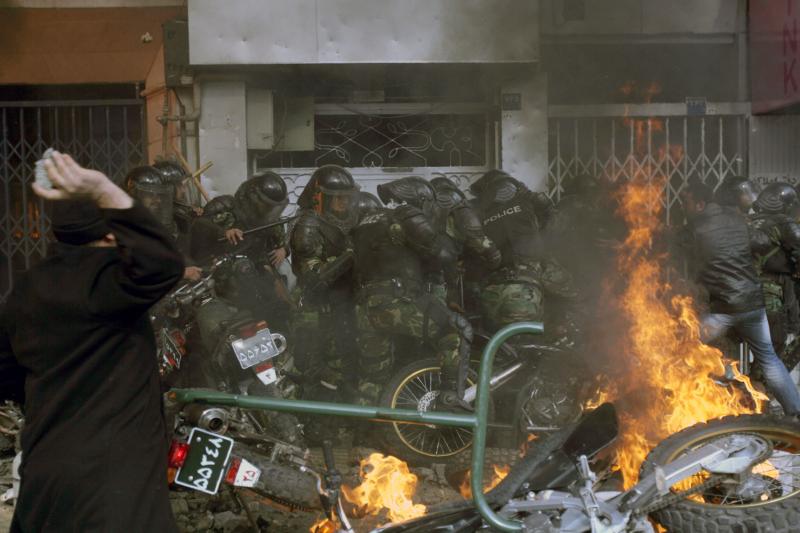 Abdolreza Mohabati, a deputy prosecutor in Tehran, said “some of those arrested were members of the Mojahedin organization who were trained in Camp Ashraf in Iraq… [and] some of the members of the organization were members of Karrubi’s election headquarters.”
Abdolreza Mohabati, a deputy prosecutor in Tehran, said “some of those arrested were members of the Mojahedin organization who were trained in Camp Ashraf in Iraq… [and] some of the members of the organization were members of Karrubi’s election headquarters.”- Sixteen defendants arrested in demonstrations on December 27, 2009, the holy day of Ashura, were brought before Judge Salavati. Fars News Agency said “Among the defendants are a number of elements affiliated to the Monafeghin terrorist group.” Another FNA report said “Some of the defendants had contacts with anti-revolutionary groups and Monafeghin. They were active with regards to organizing and efforts to plant bombs. They moved to overthrow the regime and worked in line with Monafeghin and anti-revolutionaries.”
- Judge Salavati called for the “most severe punishment” for five detainees who participated in the Ashura protests, charging them with cooperating with the PMOI. During the court proceedings, Salvati said the “core of the MEK has not been eradicated…As long as the core of that organization remains in place, all of its members and supporters…are mohareb, even if they are not involved in its armed wing.”
Anti-PMOI Exhibitions
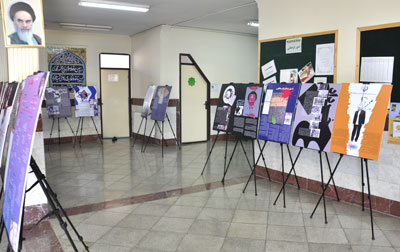 After the 2009 uprising, the ruling mullahs increased the number of anti-PMOI propaganda exhibitions. The events were mainly staged at high schools and universities to “familiarize the younger generation and especially students with the crimes of the hypocrites (PMOI/MEK).”
After the 2009 uprising, the ruling mullahs increased the number of anti-PMOI propaganda exhibitions. The events were mainly staged at high schools and universities to “familiarize the younger generation and especially students with the crimes of the hypocrites (PMOI/MEK).”
 More than 120 anti-PMOI exhibitions were organized in 36 cities across Iran between April 2010 and December 2012. The “Basirat Exhibition,” at Mashhad University in June 2011, as an example, highlighted the resistance organization’s “long history of violence and terror.” Additionally, it “dealt with the 2009 post-election riots in Iran and the role MKO [PMOI] terrorist perpetrators played during the unrests, including their direct role in the crimes of Ashura, martyr creating project, and also the shocking confessions of arrested MKO members during the riots.”
More than 120 anti-PMOI exhibitions were organized in 36 cities across Iran between April 2010 and December 2012. The “Basirat Exhibition,” at Mashhad University in June 2011, as an example, highlighted the resistance organization’s “long history of violence and terror.” Additionally, it “dealt with the 2009 post-election riots in Iran and the role MKO [PMOI] terrorist perpetrators played during the unrests, including their direct role in the crimes of Ashura, martyr creating project, and also the shocking confessions of arrested MKO members during the riots.”
At the 17th annual festival of Press and News Agencies in November 2010, the Habilian Association sponsored an exhibition titled “The Green Hypocrisy Analysis.” It presented information on the old PMOI and the “new hypocrisy (the green hypocrisy).” The exhibition distributed photographs, posters, and software products.
Although the number of exhibitions attacking the PMOI slackened beginning in 2013, the regime still sponsors such events. An exhibition in September 2014 at the Asrar Institute was designed to “promote people’s insight to the real nature of terrorist groups like the Mujahedin e-Khalq organization.”
Show Trials
To undercut the PMOI’s popularity, the Iranian regime also staged “show trials” at universities. Their purpose was to reveal the “true colors” of the PMOI, which it described as “potential enemies of the Islamic Republic.” The initial trial was held at Alama University in October 2013. An article about the exhibit said, “This trial is being held following the departure of the PMOI from Camp Ashraf, their strategic center for its activities in the region and is aimed at revealing [the] true colors of the group.”
Books, Anti-PMOI Organizations, and Attack Websites
The Iranian regime goes to great lengths to malign the PMOI. It has published hundreds of anti-PMOI books. (See list in Appendix 1.) Some of the materials are published under the name of former PMOI supporters who were coerced to join the MOIS.
The books are handed out at exhibitions and sent to government officials and reporters. In 2008, the Honorable Lord received a book titled, “A Terrorist Group with Different Faces,” about the PMOI, along with a letter without any contact details. The book’s ISBN number turned out to a forgery.
The regime has established numerous organizations whose sole purpose is to produce and distribute negative propaganda about the PMOI. These include:
- Habilian Association
- Nejat Association (has 31 branches, one in each province)
- Edalat [justice] Association
- Association for Victims of Violence
Each of the propaganda outlets has a website that daily distributes false and misleading articles about the PMOI. The regime also operates other standalone attack websites that falsely portray the resistance organization’s history and achievements. The websites endlessly repeat carefully crafted lies and fail to offer any balance or transparency. Below are some of the English language attack sites:
- Iran-Interlink.org
- CultsandTerror.org
- Irandidban.com
- SurvivorsReport.org
- Khodabandeh.org
- Saharngo.com
- Mojahedinmonitor2.blogspot.co.uk
The regime also operates attack websites in Farsi, such as:
- TheBlackFile.com
- Hasanzebel.blogfa.com
- Negaheno.net
- Zarrebin.com
Iran’s Nuclear Program
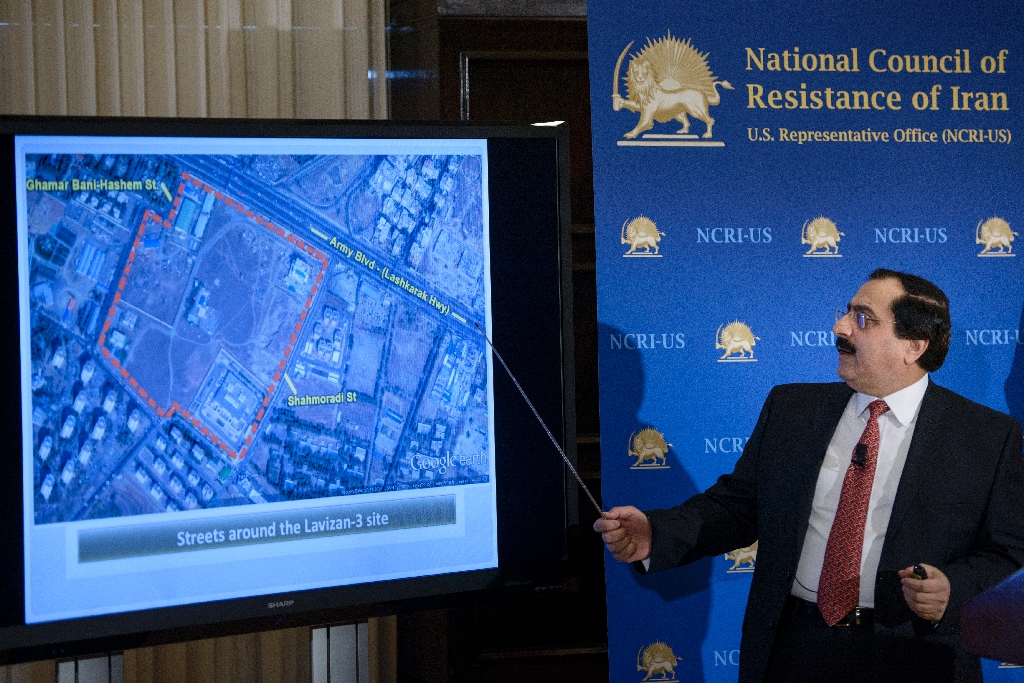 The People’s Mohahedin is opposed to the Iranian regime’s nuclear weapons program and has disclosed details on more than 100 clandestine nuclear projects in Iran. The secret information on the nuclear sites is derived from underground intelligence sources and supporters working inside the government.
The People’s Mohahedin is opposed to the Iranian regime’s nuclear weapons program and has disclosed details on more than 100 clandestine nuclear projects in Iran. The secret information on the nuclear sites is derived from underground intelligence sources and supporters working inside the government.
The PMOI’s ability to collect the sensitive information reflects its penetration of government institutions and support by the Iranian people. Below are a few of the key disclosures by the NCRI/PMOI of Iran’s nuclear weapons program:
- In 2002, the NCRI revealed at a press conference the existence of two secret nuclear sites in central Iran, a fuel production plant in the city of Natanz and a heavy water plant in Ark. The public disclosure of the nuclear sites led to a three-year investigation by the International Atomic Energy Association (IAEA), which determined the Iranian regime had concealed enrichment activities in breach of its Non-proliferation Treaty (NPT) obligations.
- In February 2003, the NCRI unmasked the Kalay-e Electric company, which the regime claimed was a watch manufacturing company, but, in fact, was a secret centrifuge assembly and testing facility. IAEA inspectors were blocked from gaining access to the site for more than a year, during which time the regime tried to remove all evidence of its nuclear activities. When inspectors were finally allowed entrance to the facility, tests revealed trace amounts of enriched uranium. The regime subsequently acknowledged it had conducted enrichment research at the site.
- In September 2008, the NCRI made public the existence of a new hardened, underground site near the Natanz facility, located in the Siah Kooh mountains. The new site is linked to Natanz with a five-kilometer tunnel and is controlled by the military, which means it is off-limits to IAEA inspectors.
 At a press conference in February 2015, the NCRI revealed details of an underground nuclear research site, known as Lavizan-3, which has been in operation since 2008. It is believed the top secret site is being used to enrich uranium and build and test advanced centrifuges. IAEA inspectors are denied access to the site because it is located within a military compound. It is estimated the facility can hold 3,000 centrifuges and is operated by Iran’s Ministry of Intelligence and Security (MOIS).
At a press conference in February 2015, the NCRI revealed details of an underground nuclear research site, known as Lavizan-3, which has been in operation since 2008. It is believed the top secret site is being used to enrich uranium and build and test advanced centrifuges. IAEA inspectors are denied access to the site because it is located within a military compound. It is estimated the facility can hold 3,000 centrifuges and is operated by Iran’s Ministry of Intelligence and Security (MOIS).
Foreign Intelligence Estimates
The Iranian regime pursues with equal vigor the destruction of the PMOI both in, and outside, Iran. Since coming to power, Iran’s mullahs have murdered at least 162 political opponents [mostly PMOI] outside Iran, according to the Iran Human Rights Documentation Center.
Iranian President Hassan Rouhani was a member of a select extra-legal committee in Iran that authorized many of the assassinations. He said in a 1994 interview with Ettela’ at, an Iranian newspaper, that, “[Iran] will not hesitate to destroy the activities of counterrevolutionary groups abroad.”
While international pressure forced the regime to curtail its violent attacks outside of Iran against the PMOI, it continues to spend vast sums on propaganda campaigns and undercover programs to discredit the organization.
Intelligence agencies in Europe closely monitor MOIS actions and confirm the regime’s aggressive efforts to weaken the PMOI. According to a report by the Netherlands’ General Intelligence and Security Service (AIVD):
- “Teheran’s efforts to undermine the opposition People’s Mojahedin Organization of Iran (Mujahedin-e Khalq, MEK) in the Netherlands continued unabated in 2011. In a campaign co-ordinated and financed by the Iranian intelligence services, the media and a number of politicians and other public servants were approached with a view toward portraying the MEK in a highly negative light.”
The Federal Office for the Protection of the German Constitution (BfV), Germany’s domestic security organization, stated in its annual report that a key activity of Iran’s intelligence services is to monitor and confront the PMOI and NCRI. The BfV said:
- “The main responsibilities of the Iranian regime’s intelligence apparatus revolve around monitoring and severely confronting opposition groups inside and outside Iran…Iranian regime’s efforts in the context of gathering information about the exiled opposition are concentrated on the PMOI and the NCRI.”
International Support
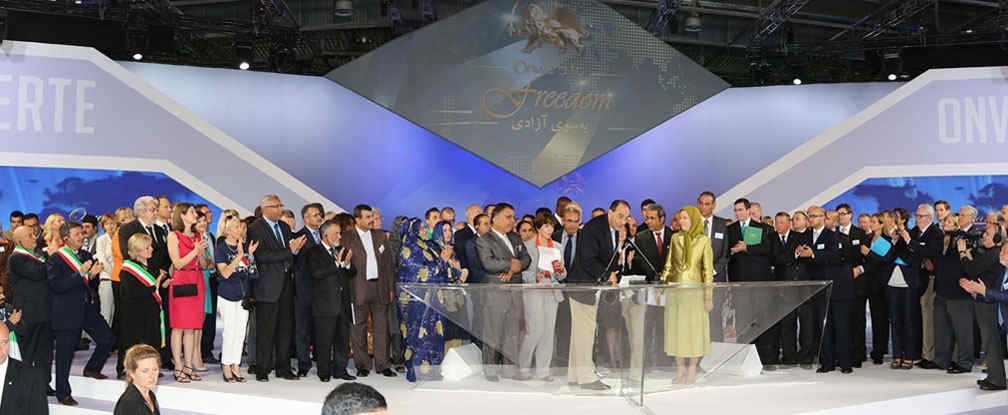 Perhaps the best indication of the PMOI’s broad popularity, dispelling the falsehood that it is an “insignificant” organization, is the support the resistance organization has received from the expat community and from former and current high-ranking government officials and associations.
Perhaps the best indication of the PMOI’s broad popularity, dispelling the falsehood that it is an “insignificant” organization, is the support the resistance organization has received from the expat community and from former and current high-ranking government officials and associations.
A large number of foreign dignitaries have publicly pledged their support for the PMOI, including former Joint Chiefs of Staff, governors, attorneys general, FBI directors, members of Congress, foreign ministers, prime ministers, human rights advocates, members of parliaments, and military officers. They all share the common goal of bringing fundamental change to Iran.
Annually in June, the NCRI/PMOI organizes a rally in Paris to commemorate the anniversary of the June 20, 1981 demonstration in Tehran. The Paris event regularly draws tens of thousands of supporters. At the June 2014 event, more than 600 officials and parliamentarians from North America, Europe, Australia, and the Middle East expressed their solidarity with the Iranian resistance organization.
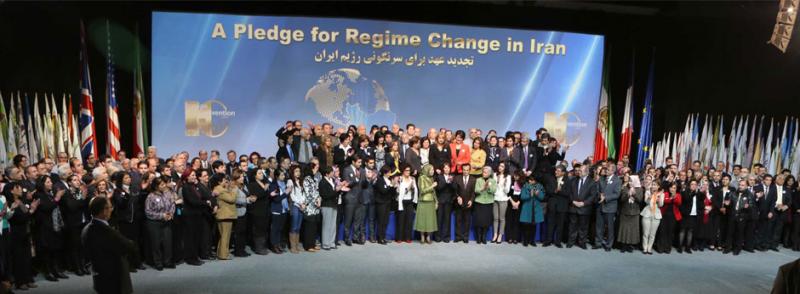 Another major event that demonstrated broad support for the PMOI was the first convention of Iranian associations in Europe, North America, and Australia.
Another major event that demonstrated broad support for the PMOI was the first convention of Iranian associations in Europe, North America, and Australia.
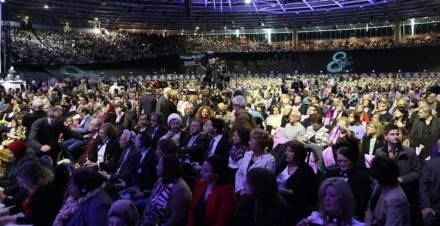 Representatives from more than 300 Iranian associations, from 18 countries, participated in the convention on February 8, 2014, the 35th anniversary of the ’79 anti-monarchial revolution. The event was one of the largest Iranian Diaspora events and featured representatives from Iranian expat associations, professionals, business people, academics, human rights activists, women’s right activists, and students, all of whom pledged their support for the PMOI and its 10-point plan for a new Iran.
Representatives from more than 300 Iranian associations, from 18 countries, participated in the convention on February 8, 2014, the 35th anniversary of the ’79 anti-monarchial revolution. The event was one of the largest Iranian Diaspora events and featured representatives from Iranian expat associations, professionals, business people, academics, human rights activists, women’s right activists, and students, all of whom pledged their support for the PMOI and its 10-point plan for a new Iran.
On February 25, 2014, 60 Iranian associations convened in Oslo, Norway, for a “Friends of a Free Iran” rally. Participants endorsed the PMOI and its 10 Point Plan for a secular, democratic government in Iran.
The Union of Iranian Associations in Germany organized a rally in Berlin on March 7, 2015, in support of the PMOI and a free and democratic Iran. The event was attended by tens of thousands of people from 40 countries. It focused attention on Tehran as the epicenter of Islamic fundamentalism and extremism.
Summary
The Iranian regime wants to destroy the PMOI because it attracts a large number of supporters who share the resistance organization’s determination to restore democracy and freedom in Iran.
Iran’s mullahs and their proxies in the US and Europe do not want to openly acknowledge the threat posed by the People’s Mojahedin and downplay the organization’s significance, claiming it is “viewed negatively by most Iranians” and has “virtually no support among the Iranian population.” In reality, there is broad public support in Iran for the PMOI and its pro-democracy agenda, and this is why the regime spends substantial time and resources to counter the organization’s influence.
After Ayatollah Khomeini came to power, the PMOI was the more popular opposition organization and nothing has changed since then. If anything, the People’s Mojahedin is more popular today given the regime’s reliance on terror to rule the country.
In 1981, the PMOI’s newspaper, the Mojahed, reached a daily circulation of 600,000 copies, the largest in the country. The resistance organization now communicates to the Iranian public via the 24/7 Iran National Television (INTV) satellite channel. Satellite dishes are pervasive in Iran despite a government ban, jamming, and confiscation campaigns. A 2013 government report acknowledged that 42% of the public watch satellite TV programs and the INTV referred to publicly as the PMOI news channel “had penetrated a majority of Iranian households.”
INTV periodically holds telethons to generate funds for its operations. A substantial number of donations come from people within Iran, even though they risk severe punishment for doing so. Their defiance reflects courage and a desire for a free and democratic government.
To counter the PMOI’s influence in Iran, the regime regularly broadcasts TV programs that demonize the resistance organization. It stages anti-PMOI exhibitions across the country and publishes scores of anti-PMOI books. The regime has set up numerous associations whose sole purpose is to vilify the People’s Mojahedin. The regime operates attack websites that daily disperse false and malicious news stories about the resistance organization, and at the end of every Friday prayer and at government rallies, supporters of the regime chant “Death to the monafeghi,” a derogatory term for the PMOI meaning hypocrite.
The regime has an active program to coerce PMOI sympathizers to work for the government’s intelligence ministry as undercover agents, who then are dispatched to Europe and the US to distribute disinformation about the resistance organization to government officials, NGOs, and the media. These actions and others by the MOIS are confirmed in reports by European intelligence organizations.
Iran’s foreign ministry takes advantage of every diplomatic opportunity to attack the PMOI and weaken its influence in the US and Europe.
One of the most telling indicators of the PMOI’s popularity and reach inside Iran is its ability to gather highly secretive information on the regime’s nuclear program. The PMOI has disclosed details on more than 100 clandestine nuclear projects in Iran. The information is provided by underground intelligence sources and supporters working inside the government.
The PMOI’s ability to directly influence events in Iran was demonstrated during the 2009 uprising. Resistance members worked behind the scenes to organize protests and transform initial objections to the fraudulent presidential election into protests against the regime. The PMOI’s anti-Islamic Republic slogans dominated events, reflecting the public’s support for the group and its pro-democracy agenda. Internal government documents reported that 60% of the youth arrested “were in contact with the Mojahedin or were influenced by them.”
The PMOI’s popularity extends far beyond Iran’s borders. The Iranian resistance and supporters of the People’s Mohajedin annually organizes a rally near Paris to commemorate the June 21, 1981 demonstration in Tehran. The Paris event attracts tens of thousands of supporters. More than 600 dignitaries from the US, Europe, Middle East, Canada, and Australia participated in the 2015 rally. Supporters of the PMOI include former Joint Chiefs of Staff, governors, attorneys general, FBI directors, members of Congress, foreign ministers, prime ministers, human rights advocates, parliamentary members, and military and intelligence officers.
A February 2014 PMOI event on the 35th anniversary of the ’79 Revolution was attended by 300 Iranian associations from 18 countries and is believed to have been one of the largest ever gatherings of the Iranian Diaspora.
Participants of these and other similar events publicly pledged their support for the PMOI and its 10 Point Plan for a secular, democratic government in Iran.
The details in this document give abundant evidence of the PMOI’s broad reach inside Iran and abroad, and the regime’s aggressive efforts to undermine the organization’s popularity. The PMOI is a formidable adversary of the Islamic Republic. It is a strong and cohesive organization that is gaining strength, presenting an escalating challenge to the survival of the ruling mullahs.
Appendix 1
Below are some of the books distributed by anti-PMOI organizations in Iran.
Islamic Revolution Document Center Website
International Support
Perhaps the best indication of the PMOI’s broad popularity, dispelling the falsehood that it is an “insignificant” organization, is the support the resistance organization has received from the expat community and from former and current high-ranking government officials and associations.
A large number of foreign dignitaries have publicly pledged their support for the PMOI, including former Joint Chiefs of Staff, governors, attorneys general, FBI directors, members of Congress, foreign ministers, prime ministers, human rights advocates, members of parliaments, and military officers. They all share the common goal of bringing fundamental change to Iran.
Annually in June, the NCRI/PMOI organizes a rally in Paris to commemorate the anniversary of the June 20, 1981 demonstration in Tehran. The Paris event regularly draws tens of thousands of supporters. At the June 2014 event, more than 600 officials and parliamentarians from North America, Europe, Australia, and the Middle East expressed their solidarity with the Iranian resistance organization.
Another major event that demonstrated broad support for the PMOI was the first convention of Iranian associations in Europe, North America, and Australia.
Representatives from more than 300 Iranian associations, from 18 countries, participated in the convention on February 8, 2014, the 35th anniversary of the ’79 anti-monarchial revolution. The event was one of the largest Iranian Diaspora events and featured representatives from Iranian expat associations, professionals, business people, academics, human rights activists, women’s right activists, and students, all of whom pledged their support for the PMOI and its 10-point plan for a new Iran.
On February 25, 2014, 60 Iranian associations convened in Oslo, Norway, for a “Friends of a Free Iran” rally. Participants endorsed the PMOI and its 10 Point Plan for a secular, democratic government in Iran.
The Union of Iranian Associations in Germany organized a rally in Berlin on March 7, 2015, in support of the PMOI and a free and democratic Iran. The event was attended by tens of thousands of people from 40 countries. It focused attention on Tehran as the epicenter of Islamic fundamentalism and extremism.
Summary
The Iranian regime wants to destroy the PMOI because it attracts a large number of supporters who share the resistance organization’s determination to restore democracy and freedom in Iran.
Iran’s mullahs and their proxies in the US and Europe do not want to openly acknowledge the threat posed by the People’s Mojahedin and downplay the organization’s significance, claiming it is “viewed negatively by most Iranians” and has “virtually no support among the Iranian population.” In reality, there is broad public support in Iran for the PMOI and its pro-democracy agenda, and this is why the regime spends substantial time and resources to counter the organization’s influence.
After Ayatollah Khomeini came to power, the PMOI was the more popular opposition organization and nothing has changed since then. If anything, the People’s Mojahedin is more popular today given the regime’s reliance on terror to rule the country.
In 1981, the PMOI’s newspaper, the Mojahed, reached a daily circulation of 600,000 copies, the largest in the country. The resistance organization now communicates to the Iranian public via the 24/7 Iran National Television (INTV) satellite channel. Satellite dishes are pervasive in Iran despite a government ban, jamming, and confiscation campaigns. A 2013 government report acknowledged that 42% of the public watch satellite TV programs and the INTV referred to publicly as the PMOI news channel “had penetrated a majority of Iranian households.”
INTV periodically holds telethons to generate funds for its operations. A substantial number of donations come from people within Iran, even though they risk severe punishment for doing so. Their defiance reflects courage and a desire for a free and democratic government.
To counter the PMOI’s influence in Iran, the regime regularly broadcasts TV programs that demonize the resistance organization. It stages anti-PMOI exhibitions across the country and publishes scores of anti-PMOI books. The regime has set up numerous associations whose sole purpose is to vilify the People’s Mojahedin. The regime operates attack websites that daily disperse false and malicious news stories about the resistance organization, and at the end of every Friday prayer and at government rallies, supporters of the regime chant “Death to the monafeghi,” a derogatory term for the PMOI meaning hypocrite.
The regime has an active program to coerce PMOI sympathizers to work for the government’s intelligence ministry as undercover agents, who then are dispatched to Europe and the US to distribute disinformation about the resistance organization to government officials, NGOs, and the media. These actions and others by the MOIS are confirmed in reports by European intelligence organizations.
Iran’s foreign ministry takes advantage of every diplomatic opportunity to attack the PMOI and weaken its influence in the US and Europe.
One of the most telling indicators of the PMOI’s popularity and reach inside Iran is its ability to gather highly secretive information on the regime’s nuclear program. The PMOI has disclosed details on more than 100 clandestine nuclear projects in Iran. The information is provided by underground intelligence sources and supporters working inside the government.
The PMOI’s ability to directly influence events in Iran was demonstrated during the 2009 uprising. Resistance members worked behind the scenes to organize protests and transform initial objections to the fraudulent presidential election into protests against the regime. The PMOI’s anti-Islamic Republic slogans dominated events, reflecting the public’s support for the group and its pro-democracy agenda. Internal government documents reported that 60% of the youth arrested “were in contact with the Mojahedin or were influenced by them.”
The PMOI’s popularity extends far beyond Iran’s borders. The Iranian resistance and supporters of the People’s Mohajedin annually organizes a rally near Paris to commemorate the June 21, 1981 demonstration in Tehran. The Paris event attracts tens of thousands of supporters. More than 600 dignitaries from the US, Europe, Middle East, Canada, and Australia participated in the 2015 rally. Supporters of the PMOI include former Joint Chiefs of Staff, governors, attorneys general, FBI directors, members of Congress, foreign ministers, prime ministers, human rights advocates, parliamentary members, and military and intelligence officers.
A February 2014 PMOI event on the 35th anniversary of the ’79 Revolution was attended by 300 Iranian associations from 18 countries and is believed to have been one of the largest ever gatherings of the Iranian Diaspora.
Participants of these and other similar events publicly pledged their support for the PMOI and its 10 Point Plan for a secular, democratic government in Iran.
The details in this document give abundant evidence of the PMOI’s broad reach inside Iran and abroad, and the regime’s aggressive efforts to undermine the organization’s popularity. The PMOI is a formidable adversary of the Islamic Republic. It is a strong and cohesive organization that is gaining strength, presenting an escalating challenge to the survival of the ruling mullahs.
-
People’s Monafeqin
-
Ancestry of Terror
-
Analyzing the People’s Mojahedin Organization’s Change of Ideology
-
Analyzing Geurilla Methods in Iran 1963-1978
-
Passing Through the Organization (Majid Sharif Waghefi as documented)
-
My Adventure with the Mujahedin-e Khalq 2001-2008
-
Like the Sun, Memories of Tahereh Sajjadi (Ghayouran) (second publication)
-
The Story of a Quagmire (the deviation and actions of Mehdi Hashemi)
Habiliyan Website
- The Ideologic Deviations of the Mujahedin-e Khalq Regarding Clergy
- Captive in Chains of Lies
- Islam and the Monafeqin
- From the Mujahedin-e Khalq to the Monafeqin
- Documents of My Conversations with Massoud Rajavi
- Unrealistic Ideal (Analyzing the actions of the People’s Mojahedin Organization)
- The Islamic Republic’s Army from Emam Khomeini’s Vision and the Mujahedin Movement
- The Dynamic Principles of the People’s Mojahedin Organization (4)
- Revelations about the People’s Mojahedin Organization
- The Hijab Revolution
- The Climax of the People’s Glory about the People’s Mojahedin Organization
- Right Opportunist
- Those Gone
- Modern Scholastic in the Rajavi Cult
- Saddam’s Private Army
- Iran Between Two Revolutions
- From the Freedom Movement to the Mojahedin
- Revelation of Two Inside Group Analysis of the Fada’i Khalq Fighters
- In the Mood of Brother Massoud
- Where Elteghat (mix of ideologies) Lead to?
- Analyzing Guerilla Methods in Iran (1963-1978)
- Extraction of the Book What Must be Done?
- With the Modern Methods of Massoud Rajavi in Reaching a Goal
- Towards the Party (Number 11)
- Humanity Know
- Deadlock of Deviation
- For History to Judge
- Analyzing a Documentary of the Position of Groups Vis-à-vis the Islamic Revolution
- Analyzing the Change in Ideology of the People’s Mojahedin Organization in 1975
- Read (Read for Iran)
- Broken Wing
- Over the Persian Gulf
- Analyzing the Status of Iranian Prisoners of War in Iraqi Camps
- Vanguards of Martyrdom in the Thrid Revolution
- Followers of Right and Wrong (7th Edition)
- Followers of Right and Wrong (5th Edition)
- Followers of Right and Wrong (4th Edition)
- Response to the Communists
- Unnecessary Projectors
- Message to the Support of the Mujahedi-e Khalq
- The Mersad Canyon
- Analysis of the People’s Mojahedin Organization of Iran
- Ancestry of Terror
- The History of Iranian Students’ Islamic Struggle outside the Country
- The Whip of Evolution
- Brief Analysis of the Iranian Society
- Analysis of a New Participation: In the Name of God and the Heroic People
- Transition or Conspiracy?!
- Investigation of the People’s Mojahedin Organization of Iran
- Political-Social Transitions (1941-1978)
- Verbal History of the Abouzar Group
- Analysis of the Mojahedin Solidarity Front
- Anti-people Terrorism (Discussion over the Nature and Goals of the Monafeqin’s Armed Movement)
- Verbal History of Heptad Islamic Struggling Groups
- Crimes Behind the Curtains
- Details of Torture 2
- Broken Vase (Memories of Ayattolah Abdul-Majid Moadi-khah)
- Details of Torturing Three Martyr IRGC Members of the Islamic Revolution Central Committee
- Monotheism Society without Classes from Imam Khomeini’s Perspective
- Iran’s Political-Religious Movements and Currents
- Monafeqin’s Image
- Why I am not a PMOI member?
- Clubwielders and Revolution from the Islamic Republic
- Monafeqn’s Image in the Quran
- What Must Be Done?
- Why Am I Returning to My Country?
- 14 years of Shiite Ideologic Rivalry in Iran – 1965 to 1977
- Islamic Revolution Party – The 28 June 1981 Catastrophe
- Islamic Revolution Party – From Founding to 28 June 1981 Catastrophe
- Some Facts on the PMOI
- Bubble on Mirage
- Memoirs of Hojjat el-Islam Doagu
- Memoirs of Hojjat el-Islam Jafar Shojuni
- Memoirs of Hojjat el-Islam Pour Hadi
- Memoirs of Javad Mansouri
- Memoirs of Mohammad Ali Gerami
- Memoirs of Haj Ahmad Ghadirian
- Memoirs of Ahmad Ahmad
- Like the Sun – Memoirs of Tahere Sajadi
- Memoirs of Seyed Mohammad Kazem Bojnourdi
- Memoirs of Mohsen Refiq Doust
- Political-Social Memoirs – Third Book
- Political-Social Memoirs – First Book
- Memoirs of Madam Behjat Afraz (Om-al Sara)
- Memoirs of Hojjat Ol-Islam Movahedi Saveji
- Memoirs of Habibollah Asgar Olladi
- Memoirs of Ayatollah Mohammad Yazdi
- Memoirs of Ahmad Mansouri
- Memoirs of Ayatollah Sheikh Ismaeel Salehi Mazandarani
- Memoirs of an Iranian Rebel
- Disarmed
- No Exit!
- Memoirs of Hojjat ol-Islam Dori Najaf Abadi
- Memoirs of Ayatollah Khoram Abadi
- Memoirs of Ezzat Shahi
- Masked Dogmatism
- Second Revelation on PMOI
- Outrage
- The Arguments of PMOI Martyr Ali Mihan Doust
- The Reserves of Imperialism (Bani Sadr and Monafeqin)
- Secrets of the 1980s
- Relief from Delusion
- The Secrets of Fire (Struggle for Freedom from Tehran to Den Hakh)
- Armed Resistance Psychology
- Rajavi Psychology
- Prophecy of Mankind
- Fighters Who Are Now Just Partying
- Psychology of Violence and Assassinations
- Night Show: Radio Iran
- Trend of Separation
- Burnt Alive in the Name of Marx and Mohammad
- Force Against Belief
- Political Biography of Martyr Rajaie
- Political Biography of Martyr Hashemi Nezhad
- The Result of Opposition inside Rajavi’s Sect
- Imam’s Explanatory Speech and the Position of Muslim Students Faithful to the Imam on the PMOI
- Rajavi’s PMOI and A Democratic Society!
- A Trend in the Life of Professor Motahari
- Mirage
- Mirage and Whirlpool
- People’s Mojahedin Organization
- PMOI: One of the Elements of Terrorism Remaining Alive in Iraq
- Fifth Column
- Rise and Fall of PMOI (1)
- Rise and Fall of PMOI (2)
- Rise and Fall of PMOI (3)
- PMOI from the Inside: Memoirs of Dr. Mohammad Mehdi Jafari
- Deceptive Martyrs
- Torture in Rajavi’s Prisons
- History and Positions of the PMOI
- Rebels with a Cause – The Failure of the Leftists in Iran
- Torture (1)
- Torture (2)
- Annexed to History’s Lashes: Shahram, Bahram, Rajavi
- The Legends of Mersad
- Engineering Operations
- Monafeqin’s Record, Massoud Rajavi (2)
- Imperialism in the Third World
- Love Prohibited!
- The Catastrophe of 5 March 1981
- A Short Look at the History of the Deeds of Iran’s Dissident Groups in Schools
- Light Without Lies, Lies Without Light
- Sects Among Us
- The Rise and Fall of the National Council of Resistance
- A Portion of Monafeqin’s Electoral Fraud
- Power and Nothing Else!
- The Nightmare of Hypocrites
- Political Autopsy of the PMOI
- What Political Current is the Candidate of Imperialism?
- Which Political Groups are Candidates of America’s Imperialism?
- Black Record (1)
- Black Record (2)
- Black Record (3)
- Black Record (4)
- Black Record (5)
- Alamout Castle: Autopsy
- Night Show: Autopsy
- A Step Further in Revealing the Monafeqin
- A Look at Monafeqin’s Nature and Actions, Massoud Rajavi
- Interview in Loneliness
- Abuzar Group
- Iran Radio Interview with Hadi Shams Haeri
- People’s Monafeqin (Hypocrits)
- Hypocrat and Monafeqin (Hypocrits)
- Political Trials in Iran
- Tireless Fighter
- Positions of Groups in Prison
- Monafeqin!
- The Monafeqin from Our View
- The Story of Guilt
- The PMOI and Marxists
- Half a Century of Memoirs and Experience
- Details on PMOI’s Ideology
- PMOI’s Role Against the Imam
- Details of the Nature and Principles of PMOI’s Beliefs
- Details of Hollow Thesis of our Tactical Alliance with the Marxists
- Influence
- Opinions of a Number of Political and Religious Figures
- Role of Dissident Groups in Relations between Iran and Iraq
- Letters of Two Former PMOI Members to Massoud Rajavi
- A Look from the Inside to Iran’s Leftist Movement
- Common Phrases and Terms of Monafeqin’s Organization
- Phrases and Terms of Rajavi’s Sect
- Reactionary
- When Curtains Are Set Aside
- Imam’s Men – Documents of SAVAK – Martyr Ghodousi
- Imam’s Men – Documents of SAVAK – Martyr Ashrafi Isfihani
- Imam’s Men – Documents of SAVAK – Martyr Sodoughi
- Imam’s Men – Documents of SAVAK – Martyr Lajevardi
- Imam’s Men – Documents of SAVAK – Martyr Hashemi Nejhad
- Imam’s Men – Documents of SAVAK – Martyr Beheshti
- Imam’s Men – Documents of SAVAK – Martyr Haghani
- Imam’s Men – Documents of SAVAK – Martyr Madani
- 20 June 1981 – Rising to the Necessity of History! or Promoting Violence?
Nejat Association
- Footprints of Demiurge
- Documents of Correspondences between Massoud Rajavi and Me
- Deception
- The Atlas of Radical Islam
- Bush, Iran and the Bomb
- Returning from Iran
- Releasing The Bonds
- The Gods of Death
- Imprisoned in the Chains of Lies
- Wounded Tulips
- Human Rights Warch Report
- Whispers Under the Trees Zizfun
- The Dark Days of Baghdad
- Imprisonment Until Separation
- Documents of PMOI’s Sectarian Meetings
- Frankfurt Meeting
- Quagmire
- PMOI in the Mirror of History
- For History to Judge
- Long Live the Burned
- Night Show with Radio Iran
- The Nature of the PMOI and NCRI
- Human Rights Violations in Rajavi’s Sect
- Obtaining Power
- The Dead-End of Devision
- Destroying Men
- The Nature of the People’s Mojahedin Organization
- Blackmail
- Peaceful Resistance: Strategy and Tactic
